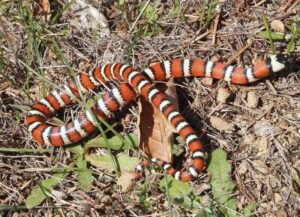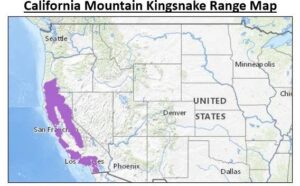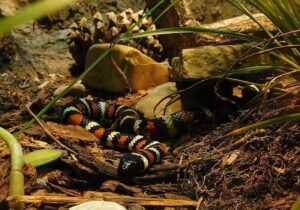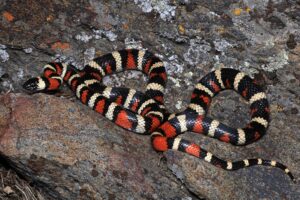California Mountain Kingsnake (Lampropeltis zonata)
Updated on
25/04/2024The California mountain kingsnake is a smooth, slender, medium-sized colubrid native to western North America. Being a coral snake mimic, the snake sports a similar pattern of red, yellow, and black repeating bands but is entirely harmless. The excellent climber leads a solitary life.
Scientific Classifications
- Suborder:Serpentes
- Family:Colubridae
- Genus:Lampropeltis
- Species:L. zonata
Conservation Status
Subspecies
The snake has seven recognized subspecies.
- Lampropeltis zonata multicincta
- Lampropeltis zonata multifasciata
- Lampropeltis zonata parvirubra
- Lampropeltis zonata pulchra
- Lampropeltis zonata zonata
- Lampropeltis zonata agalma
- Lampropeltis zonata herrerae
Description
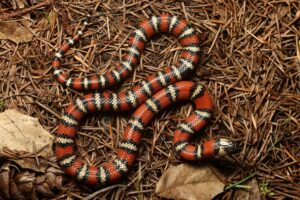
Size
The adults attain a size of 24-30 in (60.96-76.2 cm)
Color and Appearance
The banded pattern on its body is formed of red, black, and white crossbands that are always arranged in the same order. Each red crossband is bordered by two black ones forming a triad of sorts. A triad is separated from the next one by a white, cream, or yellow crossband. The undersides have fainter colors.
Some specimens have lesser amounts of red pigment and, rarely, no red bands at all, as in a population from Isla Todos Santos. It makes them resemble the related California kingsnake.
Are They Dangerous to Humans
The first reaction of the secretive snake on facing danger is to seek cover. If that is not possible, it may coil and strike. Handling makes it twist violently to escape, release feces and musk and bite viciously with teeth that can cause rather deep wounds. But the serpent has no venom.
California Mountain Kingsnakes at a Glance
Distribution
The range of the California mountain kingsnake extends from extreme southern Washington state through California and Oregon to northern Baja California. It owes its common name to the major part of its range that lies in California.
Habitat
As suggested by its common name, the species mostly lives in the mountains within its range. It can adapt to a variety of habitats, including oak-pine woodlands, coniferous forests, chaparrals, coastal sage scrubs, and riparian woodlands.
Lifespan
The California mountain kingsnake lives for 10-20 years.
Predators
Predatory birds and mammals feed on it. Its bright coloration helps it to guard itself against enemies.
Diet
They eat birds, lizards, rodents, other snakes, and many other animals owing to their extremely strong stomach acids.
Reproduction
Oviparous (lays eggs that hatch outside the body)
A female lays a clutch of 3-9 white eggs in June or July. They hatch in around 50-65 days. The hatchlings are 6-7 in (15.24-17.78 cm) in length.
Similar Species
Coral Snake
Coral snakes have red bands surrounded by white or yellow ones, while the California mountain kingsnake has red bands bordered by black ones.
Care Sheet
Size of the Enclosure: An adult can be kept in a 10-gallon cage.
Temperature: The hot end should be kept at 80°F and the cool end at 70°F. The temperature should never fall below 65°F.
Humidity: The species doesn’t need a set humidity level but some like an occasional light misting of the vivarium. A water bowl of reasonable size should be included in the cage for the pet to bathe and drink from.
Substrate: Newspaper, aspen bedding, and carefresh are good choices for the substrate.
Feeding: The hatchlings can be given lizard-scented pinkie mice to eat every 5-6 days. An adult can be fed an adult mouse every 7-10 days. The larger adults need 2 mice per feed or even rats.
Source
reptilerange.com, inaturalist.ca, birdwatchinghq.com, kidadl.com, calphotos.berkeley.edu

